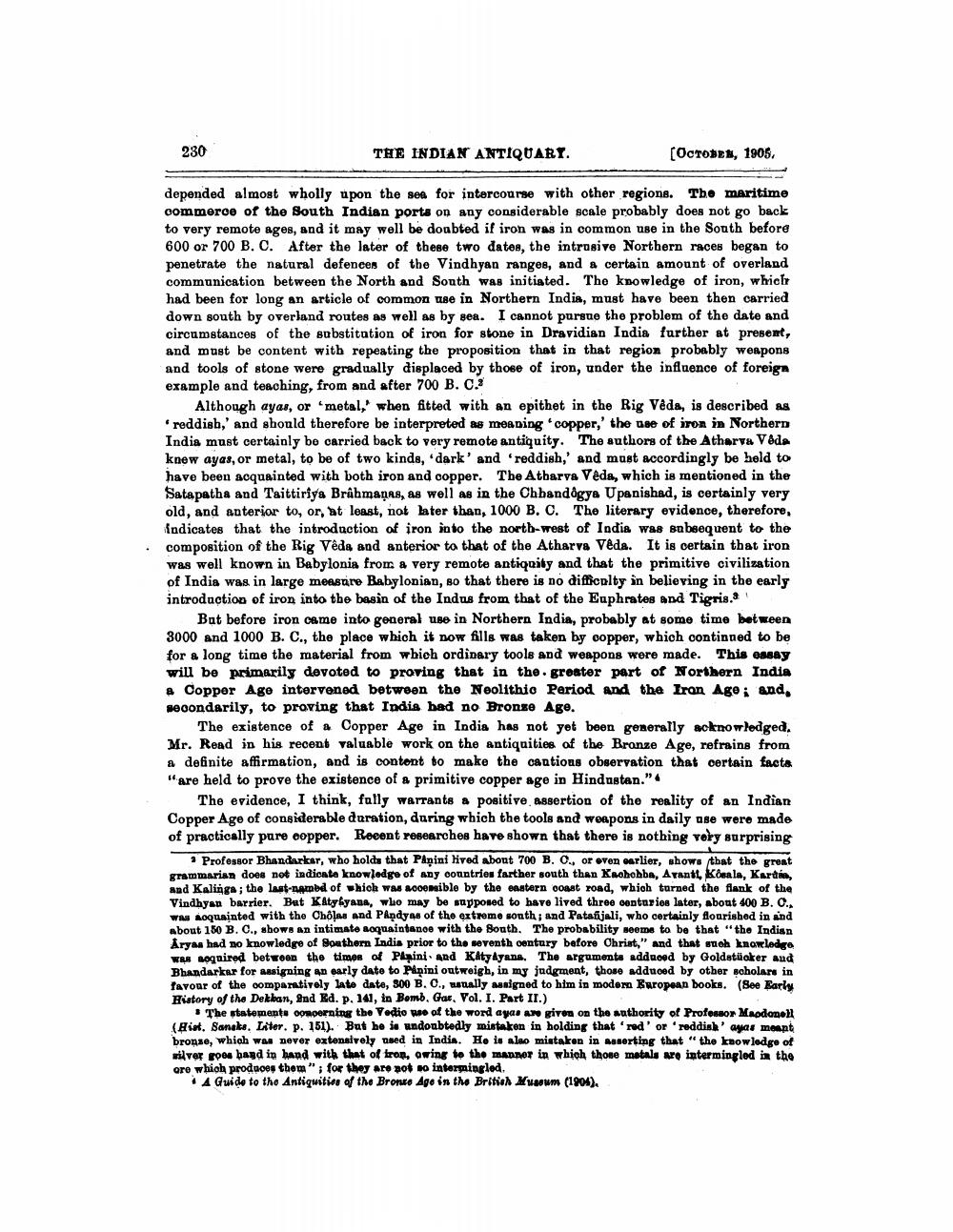________________
230
THE INDIAN ANTIQUARI.
(Octobet, 1905.
depended almost wholly upon the ser for intercourse with other regions. The maritime commerce of the South Indian ports on any considerable scale probably does not go back to very remote ages, and it may well be doubted if iron was in common use in the South before 600 or 700 B. C. After the later of these two dates, the intrusive Northern races began to penetrate the natural defences of the Vindhyan ranges, and a certain amount of overland communication between the North and Sonth was initiated. The knowledge of iron, which had been for long an article of common use in Northern India, must have been then carried down south by overland routes as well as by sea. I cannot pursue the problem of the date and circumstances of the substitution of iron for stone in Dravidian India further at present, and must be content with repeating the proposition that in that region probably weapons and tools of stone were gradually displaced by those of iron, under the influence of foreign example and teaching, from and after 700 B. C.
Although ayas, or metal,' when fitted with an epithet in the Rig Veda, is described as reddish,' and should therefore be interpreted as meaning copper,' the use of iron in Northern India must certainly be carried back to very remote antiquity. The authors of the Atharva Veda knew ayas, or metal, to be of two kinds, dark' and 'reddish,' and must accordingly be held to have been acquainted with both iron and copper. The Atharva Veda, which is mentioned in the Satapatha and Taittiriya Brâhmaņas, as well as in the Chhandôgya Upanishad, is certainly very old, and anterior to, or, at least, not later than, 1000 B. O. The literary evidence, therefore, indicates that the introduction of iron into the north-west of India was subsequent to the composition of the Rig Veda and anterior to that of the Atharva Veda. It is certain that iron was well known in Babylonia from a very remote antiquity and that the primitive civilization of India was in large measure Babylonian, so that there is no difficulty in believing in the early introduction of iron into the basin of the Indus from that of the Euphrates and Tigris.
But before iron came into general use in Northern India, probably at some time between 3000 and 1000 B. C., the place which it now fills was taken by copper, which continued to be for a long time the material from which ordinary tools and weapons were made. This essay will be primarily devoted to proving that in the greater part of Northern India a Copper Age intervened between the Neolithio Period and the Iron Age ; end. secondarily, to proving that India had no Bronze Age.
The existence of a Copper Age in India has not yet been generally acknowledged. Mr. Read in his recent valuable work on the antiquities of the Bronze Age, refrains from i definite affirmation, and is content to make the cautious observation that certain facts "are held to prove the existence of a primitive copper age in Hindustan."
The evidence, I think, fully warrants a positive assertion of the reality of an Indian Copper Age of considerable duration, during which the tools and weapons in daily age were made of practically pare oopper. Recent researches have shown that there is nothing very surprising
Professor Bhandarkar, who holds that Papini lived about 700 B. O., or even earlier, shows that the great grammarian does not indicate knowledge of any countries farther south than Kaohobba, Arantt kosala, Karta, and Kalinga; the last-nambl of which was accesible by the eastern coast road, which turned the flank of the Vindhyan barrier. Bat Katyfyans, who may be supposed to have lived three conturies later, about 400 B. O.. was aoquainted with the Cholas and Pandyes of the extreme sonth; and Patañjali, who certainly flourished in and about 150 B. C., shows an intimate acquaintance with the Boath. The probability seems to be that "the Indian Aryan had no knowledge of Southern India prior to the seventh century before Christ," and that such knowledge WRS Boquired between the times of Papini. And Kity dyana. The arguments adduced by Goldetüoker and Bhandarkar for assigning an early date to Panini outweigh, in my judgment, those adduced by other scholars in favour of the compartively late date, 300 B.O., usually assigned to him in modem European books. (See Early History of the Dekban, end kd. p. 141, in Bomb. Gar, Vol. I. Part II.)
* The statements conperning the Yodio wo of the word ayas an given on the authority of Professor Maodonell (Hist. Sanake. Liter. p. 151). But he is undoubtedly mistaken in holding that 'red' or 'reddish' ayas meant bronse, which was never extensively used in India. He is also mistaken in asserting that "the knowledge of Hilver goes bagd in hand with that of tron, aring to the manner in which those metals are intermingled in the ore which produces them", for they are not so intermingled.
* A Guide to the Antiquities of the Bronze Age in the British wawm (1904).




